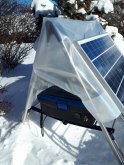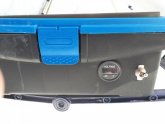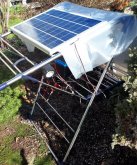Pretty cool learner setup and some comments. (Will somebody please stop me from posting walls of text!)
Inverter - I'm not entirely sure you are actually turning the inverter itself OFF after you are done with it. Idle current draw when not in use can be pretty high.
Solar panel - appears to be mono / polycrystalline. Be sure shadows from the dish-rack don't cross it, especially late afternoon where shadows can get long and have great reach. Heh, picky, but with only a 7ah battery - maybe up that to a 30 to 40 watt panel. Most conventional agm's are rated for 0.25 to 0.3C, sooo to take advantage of that (7ah * 0.3 = 2.1A max charge rate) .. Let's look at a 40w panel (40w / 18ocv = 2.22a).
Close enough for government work with a 40w panel. Especially with variable solar. We want to get in as much as we can and get to float as fast as we can with agm's because of their built-in disadvantage:
AGM: The built in disadvantage to AGM's whether 7ah or 700ah is when using them daily with solar, is that they typically never actually complete the charge. That is, the rules of phsics on them don't allow for that last 1% to get charged in a daily routine via solar, where the photons stop flowing from the sun.

Here's the deal: It takes at least 8-12 hours AFTER A FULL CV/ABSORB (like 14.6v) with an elevated float-charge at 13.6v to truly complete the process! After that, sure, you can drop to 13.2, but you can't start out that low. If you don't, you walk them down in capacity cycle by cycle as that last 1% hard-sulphates. You simply don't have enough time with agm's and solar to do it properly like you would on an ac-charger.
So what to do for daily cyclic applications? A few different options:
1) Set ALL your setpoints to 14.6 to 14.7. Bulk, absorb, float - all of it. Sun going down protects from damage.
2) If forced to drop to float by the SCC timer, raise your float to 13.6 at least. 13.7 to 13.8 better. Sun going down protects from damage.
3) If you can't do either, then at least once a month or say bi-weekly, give the batteries a day off to do nothing but float while you watch and get frustrated watching only 0.1a flow in.

It needs it.
HOT ROD IT!
Now that you know how to take care of an agm generically, let's go PURE-LEAD! Like an Odyssey agm! Look at how fast you can charge those puppies because they are pure-lead! So that means you can OVER-PANEL! And charge in 2 hours. Might be important in winter if that's all the insolation you got! Do it right and put a temperature-compensation probe on the battery terminal itself, not just rely on an SCC's ambient sensor. In your cramped case it might not matter, but why not do it right?
BUT, very expensive to get this wrong! Either by underestimating your true capacity needs, or by not charging them properly so they sulfate cycle by cycle!
The more modern answer would be to go LFP or LiFeP04! Same great taste as pure-lead agm's, but without all the calories!

That's how I got hooked on LFP personally - jumping from hammering pure-leads to LFP where lead-acid maintenance issues dropped by the wayside!
But please, put a fuse or something right next to the +positive terminal, even at this level no matter if you are using conventional agm, pure-lead agm's, or LFP.
Anyway, sorry for the wall of text, but I recognize someone who can learn and enjoy even on this small scale!










